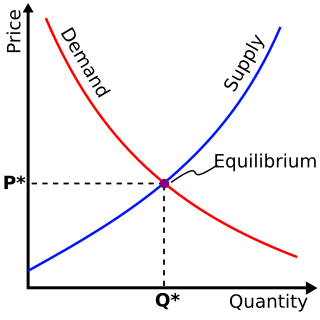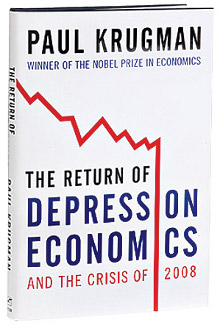Related Research Articles
Stagflation is the combination of high inflation, stagnant economic growth, and elevated unemployment. The term stagflation, a blend of "stagnation" and "inflation," was popularized by British politician Iain Macleod in the 1960s, during a period of economic distress in the United Kingdom. It gained broader recognition in the 1970s after a series of global economic shocks, particularly the 1973 oil crisis, which disrupted supply chains and led to rising prices and slowing growth. Stagflation challenges traditional economic theories, which suggest that inflation and unemployment are inversely related, as depicted by the Phillips Curve.
An economic depression is a period of carried long-term economic downturn that is the result of lowered economic activity in one or more major national economies. It is often understood in economics that economic crisis and the following recession that may be named economic depression are part of economic cycles where the slowdown of the economy follows the economic growth and vice versa. It is a result of more severe economic problems or a downturn than the recession itself, which is a slowdown in economic activity over the course of the normal business cycle of growing economy.
In economics, deflation is a decrease in the general price level of goods and services. Deflation occurs when the inflation rate falls below 0%. Inflation reduces the value of currency over time, but deflation increases it. This allows more goods and services to be bought than before with the same amount of currency. Deflation is distinct from disinflation, a slowdown in the inflation rate; i.e., when inflation declines to a lower rate but is still positive.

This aims to be a complete article list of economics topics:
Business cycles are intervals of general expansion followed by recession in economic performance. The changes in economic activity that characterize business cycles have important implications for the welfare of the general population, government institutions, and private sector firms.
In economics, aggregate demand (AD) or domestic final demand (DFD) is the total demand for final goods and services in an economy at a given time. It is often called effective demand, though at other times this term is distinguished. This is the demand for the gross domestic product of a country. It specifies the amount of goods and services that will be purchased at all possible price levels. Consumer spending, investment, corporate and government expenditure, and net exports make up the aggregate demand.

The causes of the Great Depression in the early 20th century in the United States have been extensively discussed by economists and remain a matter of active debate. They are part of the larger debate about economic crises and recessions. The specific economic events that took place during the Great Depression are well established.
Fictitious capital is a concept used by Karl Marx in his critique of political economy. It is introduced in chapter 25 of the third volume of Capital. Fictitious capital contrasts with what Marx calls "real capital", which is capital actually invested in physical means of production and workers, and "money capital", which is actual funds being held. The market value of fictitious capital assets varies according to the expected return or yield of those assets in the future, which Marx felt was only indirectly related to the growth of real production. Effectively, fictitious capital represents "accumulated claims, legal titles, to future production" and more specifically claims to the income generated by that production.

The Latin American debt crisis was a financial crisis that originated in the early 1980s, often known as La Década Perdida, when Latin American countries reached a point where their foreign debt exceeded their earning power, and they could not repay it.
A price signal is information conveyed to consumers and producers, via the prices offered or requested for, and the amount requested or offered of a product or service, which provides a signal to increase or decrease quantity supplied or quantity demanded. It also provides potential business opportunities. When a certain kind of product is in shortage supply and the price rises, people will pay more attention to and produce this kind of product. The information carried by prices is an essential function in the fundamental coordination of an economic system, coordinating things such as what has to be produced, how to produce it and what resources to use in its production.

The misery index is an economic indicator, created by economist Arthur Okun. The index helps determine how the average citizen is doing economically and is calculated by adding the seasonally adjusted unemployment rate to the annual inflation rate. It is assumed that both a higher rate of unemployment and a worsening of inflation create economic and social costs for a country.

Hyman Philip Minsky was an American economist and economy professor at Washington University in St. Louis. A distinguished scholar at the Levy Economics Institute of Bard College, his research was intent on providing explanations to the characteristics of financial crises, which he attributed to swings in a potentially fragile financial system.
Biflation is a state of the economy, in which the processes of inflation and deflation occur simultaneously in different parts of the economy. The term was first coined in 2003 by F. Osborne Brown, a senior financial analyst at Phoenix Investment Group, and has later been widely used in the media. During the biflation, there is a simultaneous rise in prices (inflation) for commodities bought out of the basic income (earnings), and a parallel fall in prices (deflation) for goods bought mainly on credit. Biflation may be seen in the CPI composition: some CPI components are in the inflationary territory, while others are facing deflationary pressure. As such, biflation reflects the complexity of the modern financial system.
Jonathan Nitzan is Professor of Political Economy at York University, Toronto, Canada.
Shimshon Bichler is an educator who teaches political economy at colleges and universities in Israel. Along with Jonathan Nitzan, Bichler has created a power theory of capitalism and theory of differential accumulation in their analysis of the political economy of wars, Israel, and globalization.
At the micro-economic level, deleveraging refers to the reduction of the leverage ratio, or the percentage of debt in the balance sheet of a single economic entity, such as a household or a firm. It is the opposite of leveraging, which is the practice of borrowing money to acquire assets and multiply gains and losses.
Inflationism is a heterodox economic, fiscal, or monetary policy, that predicts that a substantial level of inflation is harmless, desirable or even advantageous. Similarly, inflationist economists advocate for an inflationist policy.

The Return of Depression Economics and the Crisis of 2008 is a non-fiction book by American economist and Nobel Prize winner Paul Krugman, written in response to growing socio-political discourse on the return of economic conditions similar to The Great Depression. The book was first published in 1999 and later updated in 2008 following his Nobel Prize of Economics. The Return of Depression Economics uses Keynesian analysis of past economics crisis, drawing parallels between the 2008 financial crisis and the Great Depression. Krugman challenges orthodox economic notions of restricted government spending, deregulation of markets and the efficient market hypothesis. Krugman offers policy recommendations for the prevention of future financial crises and suggests that policymakers "relearn the lessons our grandfathers were taught by the Great Depression" and prop up spending and enable broader access to credit.
The internal contradictions of capital accumulation is an essential concept of crisis theory, which is associated with Marxist economic theory. While the same phenomenon is described in neoclassical economic theory, in that literature it is referred to as systemic risk.
Capital as Power: A Study of Order and Creorder is a 2009 book on economics by Jonathan Nitzan and Shimshon Bichler. The authors introduce what they describe as a "non-Marxist" account of capitalist society. Larudee wrote:
The problem, these authors say, is that both Marxians and neoclassicals view capital as a purely economic concept, in that its value of capital is determined in production, yet they do not and cannot have any valid way of independently measuring the value of capital.
References
- ↑ Differential Accumulation: Toward a New Political Economy of Capital. Nitzan 1998, p. 175
- ↑ Differential Accumulation: Toward a New Political Economy of Capital. Nitzan 1998, p. 204
- ↑ Regimes of Differential Accumulation: Mergers, Stagflation and the Logic of Globalization. Nitzan 2001, p. 232
- ↑ Regimes of Differential Accumulation: Mergers, Stagflation and the Logic of Globalization. Nitzan 2001, p. 233
- ↑ New Imperialism or New Capitalism? Nitzan and Bichler 2006, p.69.
- ↑ New Imperialism or New Capitalism? Nitzan and Bichler 2006, p.63.
- ↑ From Welltop to Laptop? From Welltop to Laptop? 2008
- 1 2 Contours of Crisis: Plus ça change, plus c'est pareil? Nitzan and Bichler 2009